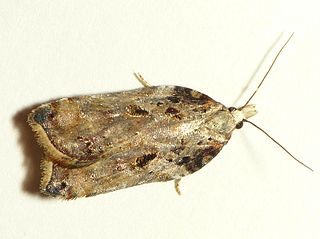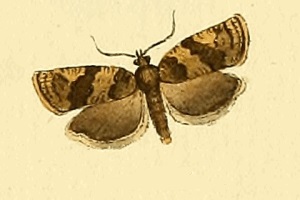
Epinotia ramella is a moth of the family Tortricidae. It is found in Europe, China, Japan, Russia and Kazakhstan.

Epinotia solandriana is a moth of the family Tortricidae. It is found in Europe, China, Korea, Japan, and Russia.
Epinotia rubiginosana is a moth of the family Tortricidae. It is found from Europe to eastern Russia, China, Korea and Japan.

Epinotia signatana is a moth of the family Tortricidae. It is found from England and Scandinavia to the Mediterranean Sea, to eastern Russia, China, Korea, Burma and Japan.

Epinotia tenerana, the nut bud moth or alder tortricid, is a moth of the family Tortricidae.

Epinotia brunnichana is a moth of the family Tortricidae. It is found in most western, central and northern Europe, the Near East and further east to the eastern Palearctic realm, where it has been recorded from Russia, Kazakhstan, China, and Japan.

Acleris cristana, the rufous-margined button moth, is a moth of the family Tortricidae and is found from Europe through the Caucasus and Ussuri to Japan.

Choristoneura diversana is a species of moth of the family Tortricidae. It is found in Great Britain, France, Belgium, the Netherlands, Germany, Denmark, Austria, Switzerland, Italy, the Czech Republic, Slovakia, Slovenia, Poland, Bulgaria, Hungary, Romania, Norway, Sweden, Finland, the Baltic region, Russia and the Near East. In the east, the range extends to China (Heilongjiang), Korea and Japan. The habitat consists of gardens, scrub and fens.
Epinotia aciculana is a species of moth of the family Tortricidae. It is found in China (Heilongjiang), Japan and the Russian Far East.

Epinotia bicolor is a species of moth of the family Tortricidae. It is found in China, Taiwan, Korea, Japan, Vietnam and India.

Epinotia contrariana is a species of moth of the family Tortricidae. It is found in China, Mongolia, Korea, Japan and the Russian Far East.
Epinotia majorana is a species of moth of the family Tortricidae. It is found in north-eastern China, Korea, Japan and Russia.
Epinotia pentagonana is a species of moth of the family Tortricidae. It is found in China (Jilin), Korea, Japan and Russia.
Epinotia pinicola is a species of moth of the family Tortricidae. It is found in China, Korea, Japan and Russia.
Epinotia rasdolnyana is a species of moth of the family Tortricidae. It is found in north-eastern China, Taiwan, Korea, Japan and Russia.
Epinotia rubricana is a species of moth of the family Tortricidae. It is found in Taiwan, Korea, Japan and Russia.
Epinotia salicicolana is a species of moth of the family Tortricidae. It is found in China (Shaanxi), Taiwan, Japan and Russia.
Epinotia ulmi is a species of moth of the family Tortricidae. It is found in China (Jilin), Korea, Japan and Russia.
Epinotia ulmicola is a species of moth of the family Tortricidae. It is found in China, Korea, Japan and Russia.
Spilonota albicana, the white fruit moth, larger apple fruit moth or eye-spotted bud moth, is a species of moth of the family Tortricidae. It is found in China, Korea, Japan and Russia. It has been accidentally introduced in the Netherlands.









